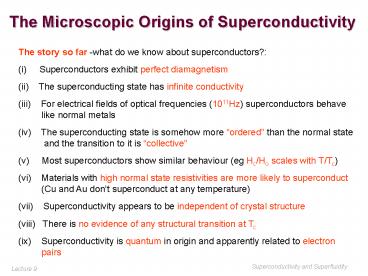The Microscopic Origins of Superconductivity - PowerPoint PPT Presentation
Title:
The Microscopic Origins of Superconductivity
Description:
In most materials the electronic properties are related to electrons at the Fermi surface ... a measure of the density of electronic states at the Fermi energy ... – PowerPoint PPT presentation
Number of Views:200
Avg rating:3.0/5.0
Title: The Microscopic Origins of Superconductivity
1
The Microscopic Origins of Superconductivity
The story so far -what do we know about
superconductors?
(i) Superconductors exhibit perfect
diamagnetism
(ii) The superconducting state has infinite
conductivity
(iii) For electrical fields of optical
frequencies (1011Hz) superconductors behave
like normal metals
(iv) The superconducting state is somehow more
ordered than the normal state and the
transition to it is collective
(v) Most superconductors show similar
behaviour (eg Hc/Ho scales with T/Tc)
(vi) Materials with high normal state
resistivities are more likely to superconduct
(Cu and Au dont superconduct at any
temperature)
(vii) Superconductivity appears to be
independent of crystal structure
(viii) There is no evidence of any structural
transition at Tc
(ix) Superconductivity is quantum in origin
and apparently related to electron pairs
Lecture 9
2
The Microscopic Origins of Superconductivity
There are a number of problems that must be
resolved
Superconductivity is clearly electronic in origin
- but it is apparently unrelated to electronic
structure
In most materials the electronic properties are
related to electrons at the Fermi surface
However the Fermi energy is several eV
For superconductors kTc 10-3 eV
and ?oHc2/2 10-5 eV
We need more clues to the nature of the
superconducting state, and this can be provided
by heat capacity measurements of the
order-disorder tarnsition at Tc
Lecture 9
3
Entropy and Specific Heat
The free energy of the superconducting state is
lower than that of the normal state at low
temperatures
The difference is ?oHc2/2 where Hc is temperature
dependent
So the latent heat (the heat necessary to make
the sample normal) is positive
The presence of latent heat defines the
transition (as a function of field) as 1st order
or discontinuous
Note that at Tc, Hc0, so LH0 and the transition
is second order or continuous
Lecture 9
4
Entropy and Specific Heat
A second order transition, such as that which
occurs at Tc, is always accompanied by an anomaly
in the specific heat
so the change in heat capacity C in cooling from
the normal (N) to the superconducting state (S)
is
At TTc we can see that the first term disappears
(as Hc 0 at Tc), but the second term remains
Note that the first term is negative - so at low
temperatures the superconducting state has a
lower heat capacity, but close to Tc it has a
higher one
Lecture 9
5
Specific Heat of a Superconductor
For a normal metal the heat capacity arises from
lattice and electronic contributions
in normal state
The Sommerfeld constant, ?, is a measure of the
density of electronic states at the Fermi energy
We usually plot C/T vs T2 to obtain A/?D3 as the
slope and ?, as the intercept
For example gallium
Lecture 9
6
Specific Heat of a Superconductor
If we plot only the electronic contribution to
the heat capacity of gallium in the
superconducting state we find ...
This form is quite general for almost all
superconductors
It implies that there is an energy gap in the
electronic states at the Fermi energy
This gap is 2? wide
? generally scales with Tc
1-10meV
2? 3.5kBTc
Lecture 9
7
Confirmation of the Energy Gap
It was mentioned early in the course that in an
electric field of optical frequencies (1011Hz)
the normal electrons start to dominate the
conduction process
also a superconductor doesnt look any
different above and below Tc
The energy gap provides an explanation
This crossover occurs at
Where Eh? is just the energy required to produce
an excitation across the gap
Lecture 9
8
The energy gap - tunneling measurements
We shall discuss tunneling in more detail later
in the course. However it is important to note
that tunneling measurements provide direct
confirmation of the superconducting gap and
enable the energy of the gap to be determined
V ?/e
Fermi Energy
Lecture 9
9
The isotope effect
One of the final clues to the origin of the
superconducting energy gap, and indeed to the
origin of superconductivity itself was the
discovery of the isotope effect
For any particular superconductor Tc depends upon
the isotopic composition of the sample
Experimentally it is found that
M?Tc constant
This, together with the observation that good
superconductors are poor noraml state conductors,
suggests that a strong electron-phonon
interaction may be a necessary condition for
superconductivity
Rather than inhibiting superconductivity, phonons
actually seem to help it!
Lecture 10































